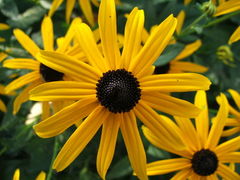Rudbeckia fulgida
| Rudbeckia fulgida subsp. var. | ||||||||||||||||||||||||||||||||||||||||||||||||||||||||
|---|---|---|---|---|---|---|---|---|---|---|---|---|---|---|---|---|---|---|---|---|---|---|---|---|---|---|---|---|---|---|---|---|---|---|---|---|---|---|---|---|---|---|---|---|---|---|---|---|---|---|---|---|---|---|---|---|

|
|
| ||||||||||||||||||||||||||||||||||||||||||||||||||||||
| ||||||||||||||||||||||||||||||||||||||||||||||||||||||||
Rudbeckia fulgida, commonly known as Black-eyed Susan, Brilliant Coneflower, Eastern Coneflower, or Orange Coneflower, is a perennial plant native to eastern North America.
Stems are hairy, ridged, and dark green. Leaves are dark green, sparsely but rouchly haired, simple, with sparsely serrate margins.
Flowers are heads, with black disk florets and bright orange ray florets, borne singly on stems that extend above the foliage.
In the garden, this plant spreads aggressively by both rhizomes and seed.
The ripe seed is a favorite food of finches in winter.
| Standard Cyclopedia of Horticulture |
|---|
|
Rudbeckia fulgida, Ait. Perennial, 1-2 ft. high: lvs. more or less hairy on both sides, the lower ones 3-nerved: rays 12-14, 1 in. long. Dry soil, Pa. to Mo., south to La. and Texas. Var. compacta, Hort., is a dwarf compact-growing form. Var. variabilis, Hort., is a form growing about 3 ft. high, with numerous rigid sts.: fls.-heads with yellow and brown ray-florets and dark purple disk-florets.
|
Cultivation
Propagation
Pests and diseases
Varieties
Gallery
-
photo 1
-
photo 2
-
photo 3
References
- Standard Cyclopedia of Horticulture, by L. H. Bailey, MacMillan Co., 1963
External links
- w:Rudbeckia fulgida. Some of the material on this page may be from Wikipedia, under the Creative Commons license.
- Rudbeckia fulgida QR Code (Size 50, 100, 200, 500)
